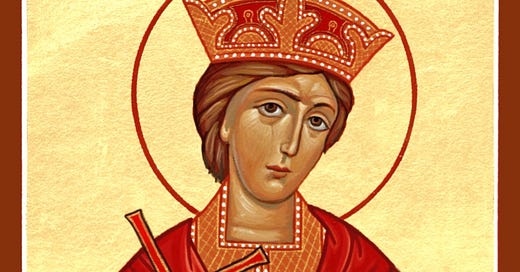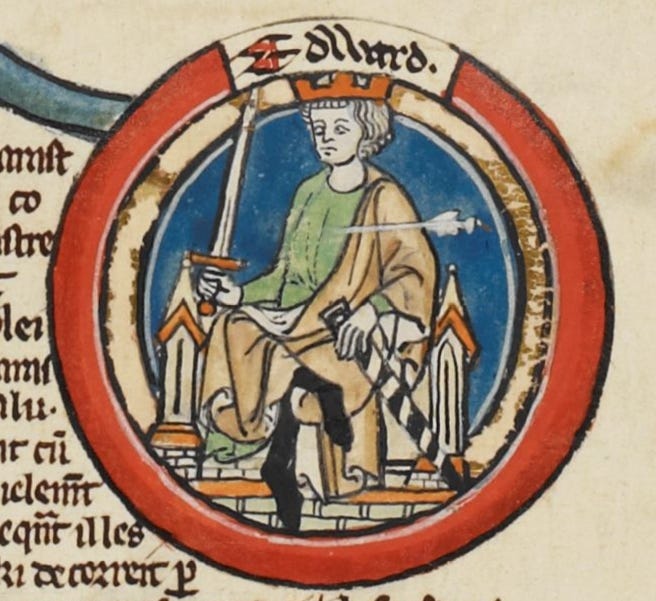This month we turn to the story of St. Edward the Martyr, great great grandson of Alfred the Great, who lived and reigned at the end of the tenth century. His feast day is celebrated on the 18th March, and he is venerated in the Anglican, Roman Catholic, and Eastern Orthodox Churches. In the Eastern Orthodox tradition he is regarded as a passion bearer, someone who faces his or her death in a Christ-like manner. Unlike martyrs, passion bearers are not directly killed for their faith, though they hold to that faith with piety and true love of God. Thus, although all martyrs are passion bearers, not all passion bearers are martyrs.
Edward the Martyr
Edward the Martyr was born c. 962. His parents were Edgar, the teenage king of England and his first wife Æthelflæd. Historians don’t know what happened to Æthelflæd, but presumably she died when Edward was very young, as Edgar remarried in 964 or 965 to Ælfthryth. Ælfthryth was the first English queen consort to be consecrated, during Edgar’s imperial coronation at Bath, and she bore Edgar two more sons, one of whom, Æthelred would survive to adulthood. Interestingly, Ælfthryth is referred to as “the legitimate wife of the king” in the charter for the re-foundation of the New Minster in Winchester in 966. This has led some historians to speculate that Edgar’s earlier relationship with Æthelflæd was an affair or in some other way irregular, rather than a formal marriage, and that Edward was thus not seen as a fully a legitimate heir. It’s also possible that this reference is an attempt by Ælfthryth and her allies, who included the powerful Bishop of Winchester, Æthelwold, to establish the primacy of Ælfthryth and her sons in the line of succession.
King Edgar died suddenly in 975, plunging England into a political crisis. Ælfthryth attempted to secure the throne for her young son Æthelred, who had been positioned as his father’s legitimate heir, but was only five or six years old. Edward, who was a teenager of thirteen or fourteen, was supported by many members of the Witan, the Anglo-Saxon council responsible for choosing the next king. We don’t know whether Edward’s supporters felt he had a better claim as the eldest son, or whether they were worried that a child monarch would result in political instability that the country could ill afford. Certainly there were heated arguments between the two factions, but after several days of wrangling Edward emerged as victor. Dunstan, Archbishop of Canterbury, threw his support behind Edward, which proved decisive in breaking the deadlock.
Edward was king, but tensions and divisions remained. Twentieth century historian Frank Stenton writes that “little can be gathered about the character of Edward’s reign beyond a vague impression of disorder”.1 This was connected as much to the monastic reforms of Edgar’s reign as to the disputed succession. As king, Edgar had thrown his support behind a group of clerical reformers led by Archbishop Dunstan and Æthelwold, Bishop of Winchester. Together they had pursued an ambitious program of monastic reform. According to Stenton, “there are few parallels in any country to the enthusiasm with which Edgar brought the whole power of the English state to the furtherance of Dunstan’s religious policy.”2
Contemporary historian Marc Morris writes that “early English monasticism had always been a very mixed bag”3 with a wide variety of communities referred to as ‘minsters’. Some, like those founded by St Wilfrid, strictly followed the Benedictine Rule, with monks living secluded and celibate lives, but many others took a more relaxed approach, and were not under any particular rule. Instead, their abbots and abbesses created their own rules for those under their care. Many monastic houses, even famous ones, also contained both celibate and secular priests. The repeated Danish raids suffered by Wessex and Mercia had been devastating for monasteries of all kinds, and by the tenth century many had disappeared entirely. “Where minsters survived into the tenth century it was usually as houses of secular clerks, who might be married and have families.”4
Influenced by a reformed and revived monasticism centred on Cluny,5 and backed by king Edgar, Archbishop Dunstan and Bishop Æthelwold led an ambitious program of reform, expelling secular clerics from monasteries across England, appointing new abbots, and founding new monastic houses sworn to follow the Benedictine Rule.6 Edgar’s “unqualified support” for ecclesiastical and monastic reform, whilst “a cause of great celebration for the reformers themselves, had led to many of his other subjects losing out”,7 most notably the secular clerks who had been expelled enmasse from religious communities across the country. Some of these came from “powerful aristocratic families that resented the assault on their kinsmen”. Perhaps more significantly, “in order to endow houses like Ely and Peterborough with large amounts of land, it had been necessary to persuade other people to part with it. Lots of laymen had been obliged to surrender estates on the grounds that they had been usurped from these monasteries in the distant past.”8 Subsequent complaints make it clear that many felt that the compensation they had received was inadequate, or that they had been forced to strike bargains with the church, but with Edgar firmly on the side of the reformers, few dared voice their discontent.
With Edgar dead, replaced by a king in his early teens, grievances that had simmered below the surface erupted violently. Across England, monasteries were attacked, their monks and abbots driven out. Some communities even reinstated the secular clerics who had previously been expelled, along with their wives and children.
The Life of Oswald mournfully records that everywhere there was “dissension and trouble, which neither the bishops nor the leading men in ecclesiastical and secular affairs was able to assuage.” It was this factional fighting that eventually led to Edward’s death.
Murder Most Foul
18th March, 978
Dusk was falling. Edward, the teenage king of England, rode through the thickly wooded countryside, a small band of soldiers at his side. Anxious to reach his destination before dark fell, the king spurred on his horse. The royal charger gradually outpaced the king’s retinue, who followed a short distance behind. The woods began to thin out, replaced by shrub and pasture land. In the distance the king could see the outline of his destination, framed against the sunset: Corfe Castle, home of his step-mother, dowager queen Ælfthryth, and his step-brother, prince Æthelred.
Edward had sent messengers ahead to warn of his arrival, so he knew his arrival was expected, even if it wasn’t welcome. His step-mother had fought tooth and nail to have her son crowned king instead of Edward, and although three years had passed, he knew bitterness and resentment remained. Perhaps he could convince the queen that he bore her and her son no ill will. At least he could try and gain his step-brother's trust. As he approached the castle, a number of armed horsemen rode to meet the king. Local magnates, loyal to the dowager queen, they greeted the king courteously and closed in behind him. Together they rode towards the gates of the castle. Reaching the gate house, the king waited on his horse for the gates to open in welcome.
A man approached the king carrying a cup of mead. “Some refreshment for your majesty?” He held the cup up.
The king, still seated on his horse, lent down to take the goblet. As he did so, the gleam of a knife flashed in the twilight, and Edward fell from his saddle, stabbed through the heart. The body of the murdered king slipped from the saddle of his horse and was dragged with one foot in the stirrup until it fell into a stream at the base of the hill upon which Corfe Castle stands. From then on the stream was believed to have healing properties.
When the queen was informed of the murder, she ordered that the body be dumped in the hut of a woman who had been blind from birth, who lived just outside the walls of the castle.
Next morning the woman was no longer blind. She told anyone who would listen that during the night, a wonderful light had appeared and filled the whole hut. Struck with awe, she had cried out: "Lord, have mercy!" and suddenly received her sight. When the queen heard about this miracle she was perturbed, and had that body buried in an unmarked grave in a nearby marsh, with none of the pomp and ceremony traditional for a royal burial. It must have seemed like he was destined to be forgotten.9
Veneration and Sainthood
Having been unceremoniously dumped in an unmarked grave, Edward’s body was not destined to remain there. Reconciliation with Edward’s supporters took some time, and Æthelred’s coronation was delayed for over a year because both archbishops refused conduct the ceremony until the body of his murdered brother had been recovered and given a proper burial. A column of fire miraculously appeared over the location of the body, and in 979 it was dug up and found to be miraculously incorrupt. Initially moved to the local village church at Wareham, after a series of miracles occurred the relics were moved to the abbey at Shaftesbury, and buried with full royal honours on the north side of the altar. He was soon venerated as a saint, with multiple miracles attributed to his relics, including the healing of lepers and the blind.
Edward was officially glorified as St Edward the Martyr by the All-English Council of 1008, presided over by St. Alphege, Archbishop of Canterbury. Æthelred, who was still on the throne, ordered that the saint's three feast days (March 18, February 13, and June 20) should be celebrated throughout England. Shaftesbury Abbey was rededicated to the Mother of God and St Edward. Shaftesbury was apparently renamed "Edwardstowe," only reverting to its original name after the Reformation. Evidence from English church calendars prior to 1100 shows that Edward’s feast day was widely celebrated across the country from an early date.
“Men murdered him, but God exalted him. In life he was an earthly king; after death he is now a heavenly saint”.
The Anglo-Saxon Chronicle
St Edward's remains were hidden during the dissolution of the monasteries, and thus preserved from desecration. In 1931, the relics were recovered by Mr. Wilson-Claridge during an archaeological excavation; their identity was confirmed by Dr. T.E.A. Stowell, an osteologist. In 1982, Mr. Wilson-Claridge donated the relics to the Russian Orthodox Church Outside Russia, which placed them in a church in Brookwood Cemetery, in Woking, Surrey. The St. Edward Brotherhood of monks was organized there, and the church is now named St. Edward the Martyr Orthodox Church.
Thank you for reading, I hope you enjoyed learning about St. Edward the Martyr. I had never heard of him before I began researching this series, and found his story fascinating. I also want to apologise for my tardiness in publishing this, I wasn’t sure if I would actually get it finished in time but I’ve managed to squeeze it in under the wire.
Frank Stenton, Anglo-Saxon England, 3rd edition, (Oxford University Press, 1971), p.372
Stenton, Anglo-Saxon England, p.367
Marc Morris, The Anglo-Saxons: A History of the Beginnings of England, (Penguin Random House, 2021), p.281
Morris, The Anglo-Saxons, p.282
The monastery at Cluny was established in 909 or 910, and rapidly became an influential model that inspired monastic reform across Europe.
Even this did not satisfy the reformers desire for monastic conformity, as there were points of difference on how the Rule of St. Benedict might be interpreted. Accordingly, Edgar summoned a synod of all the bishops in England. Æthelwold wrote up their conclusions in a documents known as the Regularis Concordia (Agreement on the Rule), and had a copy distributed to all monasteries in the country.
Morris, The Anglo-Saxons, p.317
Morris, The Anglo-Saxons, p.317
No one was ever punished for Edward’s murder, and it is not even known for certain who was involved in the plan to kill the young king. Later medieval legends cast Edward’s stepmother Æthelfryth as the wicked stepmother, accusing her of orchestrating the plot, and even of striking the fatal blow. Some modern historians have defended Æthelfryth, but it seems implausible that she did not know about and sign off on the scheme, although it is less likely that she wielded the knife herself.







Very interesting about his father King Edgar's desire to bring the monasteries back into alignment with their original purpose.